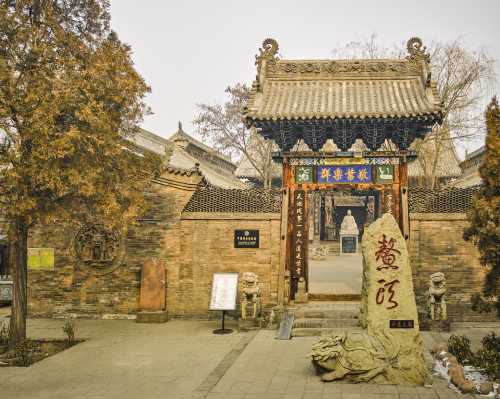Popular Trip Moments
Adding a Jin Merchant Young Mistress in Taiyuan Ancient County Town | Discover the Timeless Secret of Pingyao Ancient City | Jinzhong Three-Day Journey Through the Shanxi Merchants' Legacy | Here, there are not only brick walls and high gates but also the Jin merchants' spirit of trustworthiness worth a fortune | Super satisfied with the seven-day Shanxi travel guide | A Millennium Dream is Fen City: Rediscovering the Lost Elegance of Central China Amid Vinegar Aroma and Ancient Architecture | Stunning sunset check-in! The Orange Sea at Yingxun Gate in Pingyao Ancient City romantically debuts | Shanxi Ancient Residence Check-in | The ultimate autumn travel guide! 6 secluded scenic spots with few people, plus outfit and photography tips | Datong Yanggao Autumn Scenery Must-Visit Spot | A Journey Through the Guangxu Palace, Dreaming Back to the Qing Dynasty's Luxury! | In the golden autumn of October, I explored the millennium-old autumn scenery all over Shanxi! 4 days and 3 nights travel guide | Yongdong Palace 3-Day In-Depth Travel Guide | Shanxi Off-Season 5-Day Tour | Millennium Code Unlocked! Pingyao Ancient City Mid-Autumn Secret Revealed Must-see for a Mid-Autumn Night Tour of Pingyao Address: Kangning Road, Pingyao County, Jinzhong City, Shanxi Province | 3-Day In-Depth Itinerary for Pingyao Ancient City | Local recommendations for 9 must-visit breathtaking attractions in Shanxi during the off-season | Shanxi Off-Season Travel Guide | Off-Peak 7-Day Pure Travel in Shanxi | 7-Day Pure Travel in Shanxi (October-November) | 【Shanxi Pingyao Ancient City: The Heartbeat of the Jin Merchants' Code and the Ultimate Encounter with Ming and Qing Civilization】 | Mystic Aura | Autumn Colors in Pingyao: Picking Up a Fallen Leaf in the Old City’s Past | National Day Shanxi 7-Day Tour | National Day Shanxi 6-Day Tour | An immersive experience of traveling back to the Republic of China era in Pingyao you must stay at · Youjian Pingyao Theater Store | Autumn Colors in Pingyao: Picking Up a Moment of Slow Time in the Folds of the Ancient City | A Journey Through a Millennium-Old Jin Merchant Dream, Stepping into the Vibrant Life of the Ming and Qing Dynasties | ✨ Shanxi’s Timeless Wonders: From Hanging Temples to Lantern Nights 🏮⛰️
Recommended Attractions at Popular Destinations
Popular Attractions in Bangkok | Popular Attractions in Kuala Lumpur | Popular Attractions in Dubai | Popular Attractions in Chefchaouene | Popular Attractions in Kyoto | Popular Attractions in Los Angeles | Popular Attractions in Bali | Popular Attractions in Shanghai | Popular Attractions in Iguazu National Park(Argentina) | Popular Attractions in New York | Popular Attractions in Paris | Popular Attractions in Walt Disney World Resort | Popular Attractions in Melbourne | Popular Attractions in London | Popular Attractions in Singapore | Popular Attractions in Beijing | Popular Attractions in Las Vegas | Popular Attractions in Rome | Popular Attractions in Zanzibar Island | Popular Attractions in Sydney | Popular Attractions in West Lake | Popular Attractions in Osaka | Popular Attractions in Tokyo | Popular Attractions in Phuket | Popular Attractions in Barcelona | Popular Attractions in Madrid | Popular Attractions in Chengdu | Popular Attractions in Florence | Popular Attractions in Istanbul | Popular Attractions in Jungfrau Region
Popular Restaurants in Pingyao
Ren Zai Bei Fang Restaurant | Hong wu ji Hotel | TIANYUANKUI | YAO GONG GUAN FAN DIAN | Lao Pingyao Restaurant | 复兴公饭店 | Yunjinchenggongguan | Xijiebeibaoke Restaurant | HONG YU YUAN | 熙来遥晋菜 | Noodles & Homestyle Dishes | 董记炒碗托·裕成源店 | 梁先森·酸奶 | 谋生咖啡馆 | 喜迎春饭店(三碗不过岗店) | 晋升炉食铺 | 滨河食府(曙光东街店) | Dicos (pingyao) | Shunliuxue Noodles (pingyao) | 平遥胡记碗秃 | Tese Snack (pingyaoxianya) | 康乾记饭店 | 漂一锅柳叶面(滨河花园店) | DE CHENG LOU XIAO CHI | Shengyan Food (tiansen) | 平遥麒麟阁酒店·颐景四季厅 | 7克咖啡吧 | Hongshanyijunlanbieyuanfengwei Restaurant | 老刘家牛肉罐罐面 | Yide Hotel
Popular Ranked Lists
Top 50 Must-Visit Restaurants in Kunming | Popular Premium Hotels in Yangyang | Popular Trending Attractions in Wuyuan | Popular Premium Hotels in Shah Alam | Popular Premium Hotels in Ribandar | Popular Premium Hotels in Bedford | Top 50 Must-Visit Restaurants in Athens | Top 50 Must-Visit Restaurants in Sapporo | Popular Premium Hotels in Shirdi | Top 50 Must-Visit Restaurants in Vancouver | Popular Trending Attractions in Los Angeles | Top 50 Must-Visit Restaurants in Dubai | Top 50 Must-Visit Restaurants in Paris | Top 50 Must-Visit Restaurants in Melbourne | Popular Premium Hotels in Bowness-on-Windermere | Top 50 Must-Visit Restaurants in Frankfurt | Top 50 Must-Visit Restaurants in Berlin | Popular Trending Attractions in Singapore | Popular Premium Hotels in Shan | Popular Premium Hotels in Costa | Popular Premium Hotels in Sagres | Top 50 Must-Visit Restaurants in New York | Popular Trending Attractions in Takayama | Popular Trending Attractions in Ejin Banner | Top 50 Must-Visit Restaurants in Koh Samui | Popular Premium Hotels in Mlini | Popular Trending Attractions in Bali | Top 20 Trending Attractions in Harbin | Top 50 Must-Visit Restaurants in London | Popular Premium Hotels in West Yorkshire
About
Payment methods
Our partners
Copyright © 2025 Trip.com Travel Singapore Pte. Ltd. All rights reserved
Site Operator: Trip.com Travel Singapore Pte. Ltd.
Site Operator: Trip.com Travel Singapore Pte. Ltd.








